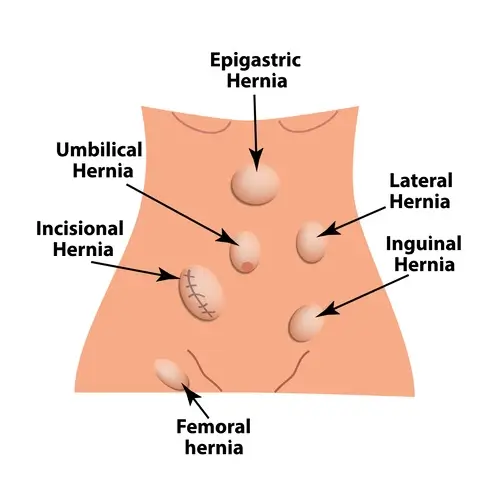The world of hernias can appear overwhelming. They sound and look painful, some are more common than others, and to top it off, there are several different types that can develop. The good news is, this blog aims to reveal the mysteries of the different types of hernia, examining their symptoms to help you get a faster diagnosis and seek the right treatment.

Wellsoon private healthcare
Wellsoon is a service from Practice Plus Group that provides a range of treatments for patients paying for themselves or paying by private medical insurance. With no hidden costs, you’ll pay less than you might think and be back to your best sooner than you thought.
- £95 consultation within 1 to 2 weeks* – includes x-ray, bloods and swabs
- Surgery in just 4 to 6 weeks*
- Experts in hips, knees, eyes, hernias and more
- Pay for yourself or via health insurance
- 0% finance options available

Hernia types and locations
Hernias can occur in various different parts of the body. They are often found where there is a weakness or gap in the muscles or tissue that normally holds organs in place. The most common areas to experience hernias are:
- the groin
- the stomach.
Hernia types diagram
The six most common types of hernias and their locations on the body are documented in the diagram below:

How many different types of hernias are there?
There are lots of different types of hernias. However, the six most common are:
- Inguinal
- Femoral
- Umbilical
- Incisional
- Hiatal
- Epigastric.
What types of hernias are there?
The different types of hernias generally occur in the groin or stomach. We take a look below at the most common types, who is most at risk, the symptoms, and the most effective treatments.
Inguinal hernias
This is the most common type of hernia. Inguinal hernias occur when part of the intestine or other tissue pushes through a weakness in the abdominal muscles or the inguinal canal.
Who gets them?
This type of hernia is more common in older men. Among the other risk factors are a genetic history of hernias or obesity.
Common symptoms
- a lump in the groin that might become more noticeable when standing or straining
- pain or discomfort in the groin, especially when lifting or coughing
- pressure or weakness in the groin
- swelling or redness.
Inguinal hernias can occasionally cause nausea and vomiting. This could be a sign of a serious complication.
Treatment
Inguinal hernias are almost exclusively treated through hernia repair surgery. However, if the hernia is small and isn’t causing you any discomfort, you may not need an operation.
Femoral hernias
This type of hernia occurs when a part of the intestine or other tissue protrudes through a weak spot in the abdominal muscles. This typically happens in the upper thigh.
Who gets them?
Femoral hernias are more common in women. Risk factors include pregnancy, obesity and chronic strain.
Common symptoms
- a bulge or lump in the groin or upper thigh area
- pain or discomfort in the groin or upper thigh, especially when coughing, lifting or bending over
- weakness or pressure in the groin or upper thigh area
- nausea or vomiting (in rare cases).
Treatment
Femoral hernias are treated the same way as inguinal hernias: reparative surgery is used when needed. Learn more about the risks and benefits of hernia surgery.
Hiatus hernias
This type of hernia occurs when a part of the stomach pushes up through the diaphragm into your chest cavity.
Who gets them?
Hiatus hernias are more common in adults aged over 50. Other risk factors include obesity and smoking.
Common symptoms
Although some people may not experience any symptoms at all, Hiatus hernias present a range of symptoms. These can include:
- heartburn
- regurgitation
- sharp or dull chest pain
- difficulty swallowing
- nausea or vomiting
- burping or bloating.
Treatment
Treatment depends on the type and severity of the hernia, but patients may be advised to lose weight, improve their diet or take prescribed medication. Unfortunately, Practice Plus Group is unable to offer treatment for hiatus hernias.
Incisional hernias
This type of hernia occurs at the site of a previous abdominal surgery. It is typically found where the original incision did not heal properly.
Who gets them?
Incisional hernias can occur in anyone who has had abdominal surgery in the past.
Common symptoms
Common symptoms include:
- a bulge or swelling near the surgical incision
- pain or discomfort in the area
- a feeling of pressure or heaviness in the abdomen
- nausea or vomiting
- difficulty passing stool or gas
- fever or chills (in rare cases).
Treatment
Treatment depends on the size and complexity of the hernia. It will also take your health and medical history into account. Your doctor or surgeon may decide to monitor the hernia to see if it gets bigger or causes complications. In some cases you may need surgery. Excluding Laparoscopic hernia repair, incisional & recurrent surgery require a surgical assessment to confirm suitability of the proposed treatment centre. We may be unable to deal with this locally and you may need to be transferred to another care facility.
Umbilical hernia
This type of hernia happens when a part of the intestine pushes through a weak spot near the belly button. In babies, an umbilical hernia occurs when the muscles around the belly button don’t close completely after birth, causing a small bulge to appear.
Who gets them?
Umbilical hernias are more common in babies and young children, but can occur in adults too. Women are more likely to develop them than men, and the risk increases with age.
Common symptoms
- a bulge or swelling around the belly button area is the most common symptom
- pain or discomfort around the belly button, especially when coughing, sneezing or lifting heavy objects
- redness or swelling around the belly button
- nausea or vomiting if the hernia becomes incarcerated or strangulated
- (in infants) a soft bulge around the belly button that appears when crying or straining.
Treatment
In infants, most umbilical hernias resolve on their own by the age of one or two without the need for treatment.
In adults, treatment will depend on the size of the hernia and your symptoms. There is a risk this could turn into an incarcerated hernia. This is a serious complication that requires emergency surgery.
Muscle hernias
Muscle hernias (sometimes called myofascial hernias) occur when muscle tissue pushes through a weakened area in the fascia. The fascia is the connective tissue that surrounds and separates muscles.
This type of hernia can happen due to a sudden injury or repetitive strain over time. Muscle hernias can occur in any muscle but they are most common in the lower leg.
Who gets them?
Anyone can get a muscle hernia but they are more likely as we age and our muscles get weaker. Athletes or people who participate in sports that involve sudden, repetitive movements such as running or kicking may be more likely to develop this type of hernia.
Common symptoms
While muscle hernias do not always have noticeable symptoms, the most common are:
- a bulge or lump in the affected muscle
- pain, tenderness or weakness in the affected area.
Treatment
Treatment usually includes rest, physiotherapy or surgery. Unfortunately, Practice Plus Group is unable to offer treatment for muscle hernias.
Spigelian hernias
These are rare types of hernias that occur along the tissue of the abdominal wall, below the ribcage and above the hip bone.
Who gets them?
Spigelian hernias are most common in women.
Common symptoms
This type of hernia can be tricky to diagnose. Symptoms can include:
- a bulge or lump in the abdominal wall is the most common symptom and may be more noticeable when standing or straining
- pain or discomfort in the abdomen that could be sharp or dull and may come and go
- nausea or vomiting, especially if the hernia becomes incarcerated or strangulated
- constipation or other bowel changes.
Treatment
Treatment usually involves surgery to repair the hernia and strengthen the weakened abdominal wall. If left untreated, a Spigelian hernia can become larger and more painful over time. It may also lead to serious complications. Unfortunately, Practice Plus Group is unable to offer treatment for Spigelian hernias.
Diaphragmatic hernias
A diaphragmatic hernia occurs when part of one of the abdominal organs (such as the stomach, intestine or liver) pushes through a weakened or torn area in the diaphragm. The diaphragm is a large muscle that separates your chest from your abdominal cavity.
Who gets them?
This type of hernia can be congenital (present at birth) or acquired (as a result of trauma or injury to the diaphragm).
Acquired diaphragmatic hernias are less common than congenital hernias and may occur as a result of trauma or injury to the chest or abdomen.
Congenital diaphragmatic hernias are more common in babies and men.
Common symptoms
- chest pain or discomfort
- difficulty breathing
- abdominal pain
- nausea or vomiting
- difficulty swallowing.
In some cases, a diaphragmatic hernia may be asymptomatic and only discovered during imaging tests for other conditions.
Treatment
Treatment usually involves surgery. Unfortunately, Practice Plus Group is unable to offer treatment for Diaphragmatic hernias.
Epigastric hernias
This type of hernia occurs when a part of the intestine or other tissue protrudes through a weak spot in the abdominal muscles. It normally occurs in the upper abdominal area.
Who gets them?
Epigastric hernias are more common in men.
Common symptoms
This type of hernia often doesn’t cause any noticeable symptoms. However, they may cause pain or discomfort in the upper abdomen, especially during physical activity or when lifting heavy objects.
Treatment
Treatment usually involves surgery. If left untreated, an epigastric hernia can become larger and more painful and may even become incarcerated or strangulated. This can be a medical emergency. Unfortunately, Practice Plus Group is unable to offer treatment for Epigastric hernias.
Ventral hernias
Ventral hernias can occur anywhere on the abdominal wall.
Who gets them?
Ventral hernias can be caused by a variety of factors, including obesity, pregnancy, previous abdominal surgery or a congenital defect.
Common symptoms
- a visible bulge or swelling in the abdomen
- pain or discomfort
- digestive issues like nausea and vomiting.
Treatment
Treatment usually involves surgery to repair the weakened area. Unfortunately, Practice Plus Group is unable to offer treatment for Ventral hernias.
Recurrent hernias
A recurrent hernia is a hernia that occurs in the same location where a previous hernia repair was performed.
Common symptoms
Symptoms can include pain, swelling and a bulge or lump in the same location as the previous hernia.
Treatment
Treatment options may include surgical repair using a different technique or material. Alternatively, you may be advised to wear a hernia belt. Excluding Laparoscopic hernia repair, incisional & recurrent surgery require a surgical assessment to confirm suitability of the proposed treatment centre. We may be unable to deal with this locally and you may need to be transferred to another care facility.
Understanding the different types of hernia symptoms
Hernias can cause a range of symptoms depending on the type, location and severity of the hernia. Sometimes, there are no symptoms at all, and occasionally the symptoms aren’t noticeable. The most common symptom is a bulge or lump in the groin or stomach.
Different types of hernia surgery explained
The type of treatment you receive will depend on the type of hernia you have. Some hernia consultants will recommend hernia surgery which involves pushing the protruding tissue back into place and strengthening the surrounding muscle tissue with sutures or mesh. Other forms of hernia prevention and treatment may include pain medication and the use of a hernia belt for support.
Keyhole hernia surgery
Sometimes called laparoscopic hernia repair, keyhole surgery is when your hernia surgeon uses an instrument called a laparoscope (a thin telescope with a light) that is passed through the abdominal wall via small incisions.
Open hernia surgery
During open hernia repair surgery, your surgeon will make an incision over your hernia. They will then push the protruding tissue back through the muscle before closing the incision.
Hernia types FAQs
Not yet found what you’re looking for? Our hernia FAQs might be able to help.
The most common types of hernias are inguinal and femoral hernias.
Inguinal hernias are the most common form of hernia in men.
Femoral hernias are the most common form of hernia in women.
The rarest types are:
- Spigelian hernia
- Obturator hernia
- Lumbar hernia
- Richter’s hernia
These rare types of hernias may be difficult to diagnose and require specialised surgical techniques.
The most serious type of hernia is a strangulated hernia. This occurs when the blood supply is cut off which can cause tissue death (necrosis) and potential damage to your surrounding organs. Strangulated hernias are considered a medical emergency and require immediate surgical intervention.
A strangulated hernia most commonly occurs with inguinal and femoral hernias, but can be a result of any other type.
Symptoms may include severe pain, fever, nausea (and vomiting) and abdominal swelling or redness.
It’s important to remember that, if left untreated, any type of hernia can lead to complications. However, small hernias that are not causing any symptoms may typically be considered relatively harmless.
For example, small inguinal hernias may be monitored by a doctor rather than immediately treated with surgery.
Hernias are usually diagnosed and treated by general surgeons. In some cases, other specialists such as gastroenterologists or urologists may also be involved in your treatment.
If you suspect you may have a hernia, you typically have two options:
- see your GP who can refer you for further treatment (if needed)
- submit an enquiry with Practice Plus Group.
Your consultant will typically do a physical examination and may order imaging tests. These will normally be either CT or an ultrasound scan which will confirm the diagnosis and determine the right course of treatment.
Hiatal hernias can cause acid reflux symptoms. Hiatal hernias occur when a part of the stomach squeezes up into the chest cavity through the hiatus, an opening in the diaphragm. This can cause acid from the stomach to flow back up into the oesophagus, leading to symptoms such as heartburn, regurgitation and difficulty swallowing.
Not all types of hernias require surgery. In some cases, small hernias that aren’t currently causing symptoms or complications may be managed through regular monitoring.
However, many hernias do require surgical intervention to repair the hernia. These can also prevent complications such as strangulation or obstruction.
If you think you may have a hernia and are looking for treatment, don’t hesitate to get in touch.





